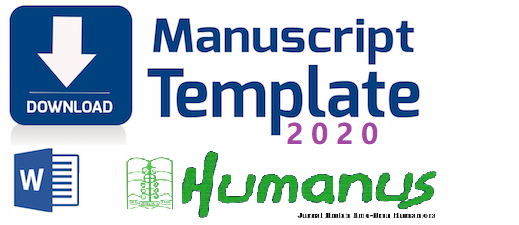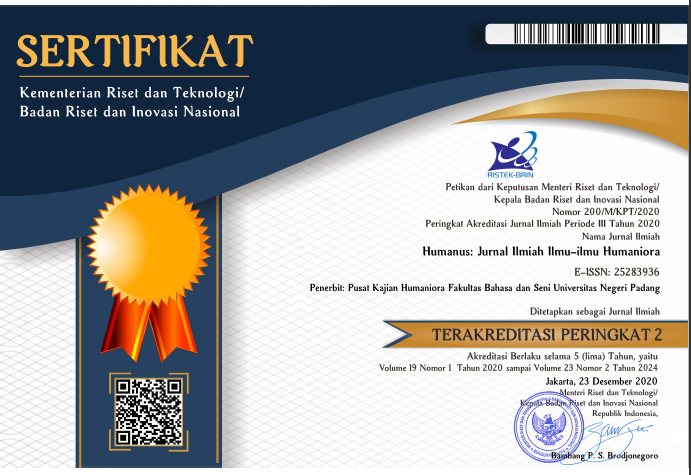INTERNAL INNOVATION OF TABA IN NORTHERN MALUKU HISTORICAL LINGUISTICS PERSPECTIVE
 ),
), (1) Universitas Mataram
 Corresponding Author
Corresponding Author
Copyright (c) 2018 Humanus
DOI : https://doi.org/10.24036/humanus.v16i2.8293
Full Text:
 Language : ind
Language : ind
Abstract
Key words: internal innovations, historical linguistics, phonological innovations, lexical innovations.
INOVASI INTERNAL BAHASA TABA DI MALUKU UTARA: PERSPEKTIF LINGUISTIK HISTORIS
Abstrak
Tulisan ini bertujuan menjelaskan inovasi internal aspek fonologi dan leksikal bahasa Taba di Maluku Utara dari perspektif studi linguistik historis. Data berupa 200 kosa kata dasar dan 1000 kosa kata budaya telah dikumpulkan dengan metode wawancara/cakap teknik catat dan rekam dalam bahasa Taba, dan lima bahasa lain yang sekerabatnya dengannya, yaitu Buli, Maba, Sawai, Gebe, dan Gane. Lalu, data dianalisis menggunakan pendekatan horizontal metode padan intralingual, teknik hubung-banding. Dalam bahasa Taba setidak-tidaknya memiliki sembilan kecenderungan fonologis yang tidak dimiliki oleh bahasa Halmahera Selatan lainnya. Yaitu, (1) merealisasikan bunyi /s/ pada posisi akhir yang diawali konsonan dental /d, t/; (2) mengalami penghilangan suku awal, sedangkan bahasa lain sebaliknya (muncul); (3) merealisasikan vokal /o/ (perendahan vokal) pada silabe penultima (atau pada urutan i-o pada silabe berbeda); (4) merealisasikan konsonan /h/ baik pada silabe penultima maupun ultima; (5) merealisasikan konsonan /c/ pada posisi awal; (6) merealisasikan vokal /a/ secara teratur pada silabe awal penultima; (7) terjadi penghilangan suku awal diikuti oleh penambahan fonem atau silabe pada posisi akhir; (8) merealisasikan /k/ pada posisi akhir; serta (9) merealisasikan bunyi /h/ pada posisi tengah. Adapun inovasi leksikal (perbedaannya dengan lima bahasa Halmahea Selatan lainnya secara horizontal) di antaranya dapat ditemukan pada kata yang bermakna ‘awan’, ‘baik’, ‘belok’, ‘gigit’, ‘dekat’, ‘ikat’, ‘jahit’, ‘jarum’, ‘jika, kalau’, dan sebagainya.
Kata kunci: inovasi internal, linguistik historis, inovasi fonologi, dan inovasi leksikal.
Keywords
References
Badan Bahasa. (2014). Bahasa dan Peta Bahasa di Indonesia. Jakarta: Departemen Pendidikan Nasional.
Blust, R. A. (1978). Eastern Malayo-Polynesian: a subgrouping argument. Halaman 181-234 Nomor 61 Pacific Linguistics Series C. Dalam S.A. Wurm and Lois Carrington (eds). Second international conference on Austronesian linguistics proceedings. Canberra: Department of Linguistics, Research Schools of Pacific Studies, The Australian National University.
Blust, R. A. (2013). The Austronesian Languages. Revision Edition. Canberra: Pacific Linguistics.
Blust, R. A. & S. Trussel. (2014). Austronesian Comparative Dictionary. Available online at ww.trussel2.com/ACD .
Bowden, J. (2001). Taba: Descripstions of a South Halmahera Language. Canberra: Pacific Linguistics.
Burhanuddin. (2016). Hubungan Kekerabatan Bahasa-Bahasa Subrumpun Halmahera Selatan di Halmahera Selatan. Disertasi S3. Surakarta: Universitas Sebelas Maret.
Hughes. J. (1987). The Languages of Kei, Tanimbar, and Aru: A Lexicostatistics Classification. Historical Linguistics in Indonesia Jornal, Part I, Nomor 10, halaman 21-30. Jakarta: Badan Penyelenggara Seri NUSA.
Kamholz, D. C. (2014). Austronesians in Papua: Diversification and Change in South Halmahera-West New Guinea. Disertasi for Doctor of Philosophy. Berkeley: University of California.
Mahsun. (2013). Metode Penelitian Bahasa. Edisi Revisi. Jakarta: Rajawali Grafindo.
Masinambow, E.K.M. (1976). Konvergensi Etnolinguistik di Halmahera Tengah: Sebuah Analisa Pendahuluan. Semarang: IKIP Semarang Press.
 Article Metrics
Article Metrics
 Abstract Views : 437 times
Abstract Views : 437 times
 PDF Downloaded : 158 times
PDF Downloaded : 158 times
Refbacks
- There are currently no refbacks.
Copyright (c) 2018 Humanus

This work is licensed under a Creative Commons Attribution-NonCommercial 4.0 International License.










